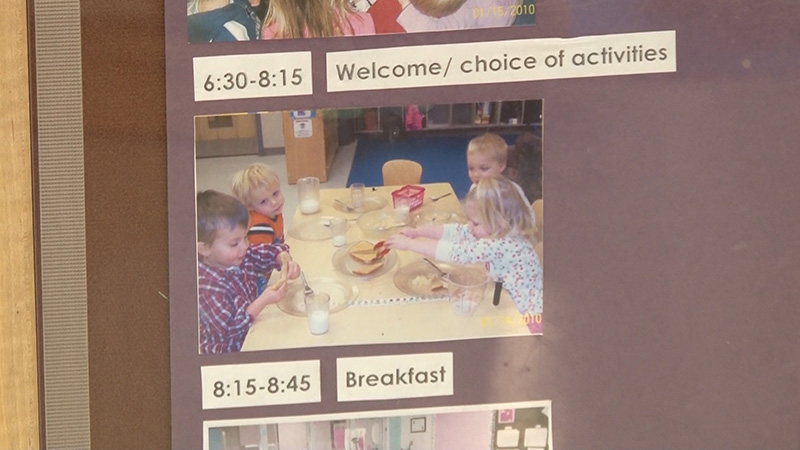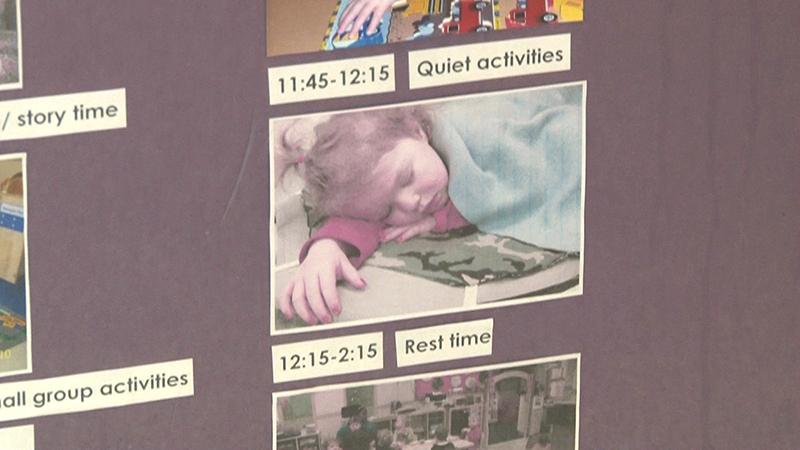本课程描述了您的婴儿和蹒跚学步的早期保健和学习环境如何支持自我调节的发展,并有助于防止具有挑战性的行为。狗万app怎么下载可预测的时间表,响应例程和学习环境的物理设计都影响了积极指导的推广。狗万app怎么下载
Secondary tabs
- 确定环境可以帮助支持自我监管的方式。
- 探讨环境可以提供额外的帮助support and prevent challenging behaviors.
- 学ways to support infants, toddlers and families through consistent and responsive routines and transitions.
学
知道
What comes to mind when you think about the word, “Environment”? The environment includes not only the physical space and furniture arrangement, but the people, routines, schedules, experiences and emotional tone of the space.
儿童发展的基本技能self-regulation in the first five years of life, which means caregivers and early-childhood teachers play important roles in helping young children regulate their thinking and behavior. As an infant and toddler caregiver, you have an opportunity to continue to explore the ways the environment can be used as a powerful tool to support the development of self-regulation and to prevent challenging behaviors. For very young infants who cannot move themselves from one activity to another, the environment is particularly important. The physical environment, group size, daily schedules, plans, and routines should encourage infants’ and toddlers’ sense of security and safety.
创建支持婴儿和幼儿的环境
 Environments are a crucial element of infant and toddler care. It is the adult caregiver who decides what infants and toddlers see, touch, and hear. They make decisions about how much fresh air, sunlight, and exercise infants and toddlers will have. Adult caregivers create the physical space, select materials and toys, and provide interactions and experiences that help make up the day for infants and toddlers. Infants and toddlers rely on adults to create an environment that supports relationships, encourages responsive care from adults, and is appropriate for their age, development, interests and culture.
Environments are a crucial element of infant and toddler care. It is the adult caregiver who decides what infants and toddlers see, touch, and hear. They make decisions about how much fresh air, sunlight, and exercise infants and toddlers will have. Adult caregivers create the physical space, select materials and toys, and provide interactions and experiences that help make up the day for infants and toddlers. Infants and toddlers rely on adults to create an environment that supports relationships, encourages responsive care from adults, and is appropriate for their age, development, interests and culture.
从他们出生的那一刻起,婴儿参加了多个感觉,如灯光,声音,运动,饥饿,疲劳等。幼儿感知和回应感官信息的方式影响他们如何回应他们周围的世界,包括人,包括人们,及其持续发展的自我监管。例如,一个对声音更敏感的幼儿可能很容易被淹没,在早期保管和学习环境中始终播放。狗万app怎么下载护理人员可能会注意到这个幼儿击中同行,遇到目光接触的困难,在噪声水平高于往常时延长一段时间。
As an infant and toddler caregiver, you have the opportunity to stay connected with a young child’s family. Connections with young children’s families help you find ways to support infants’ and toddlers’ unique needs, which helps young children regulate behaviors and feel safe and successful in the care setting. Ongoing observation can also provide clues about how a young child is seeing, making sense of and responding to the environment.
以下是环境如何能够直接影响社会发展,以及在您的早期保证和学习环境中考虑的策略,以支持自我调节,并防止具有挑战性的行为:狗万app怎么下载
 Responsive, consistent routines and schedules help strengthen relationships between infants, toddlers, and their caregivers. This provides security and a sense of control, letting infants and toddlers know what is coming next, which allows them to relax and explore their environment. Well-developed clear and consistent schedules and routines can help keep toddlers engaged in the day’s activities, prevent distress, and reduce anxiety in young children, especially those who are resistant to change or surprises.
Responsive, consistent routines and schedules help strengthen relationships between infants, toddlers, and their caregivers. This provides security and a sense of control, letting infants and toddlers know what is coming next, which allows them to relax and explore their environment. Well-developed clear and consistent schedules and routines can help keep toddlers engaged in the day’s activities, prevent distress, and reduce anxiety in young children, especially those who are resistant to change or surprises.- Post family photos that infants and toddlers can see throughout the day.
- Use a streamer near a fan to help create white noise which reduces distracting noise.
- 在白天谈论家庭,让婴儿和幼儿知道他们的父母正在考虑他们。
- 提供响应幼儿发展和兴趣的玩具和材料。
考虑时间表和例程时
Managing time and the sequence of events that occur each day is an important part of positive guidance. A regular schedule can prevent behavioral outbursts and reduce anxiety in children. Providing structure and predictability helps everyone know what is to be expected throughout the day. Below are some suggestions for your infant and toddler environment:

 在年轻的孩子的眼睛水平上发布当天活动的视觉计划,所以他们知道接下来是什么,帮助他们了解事件的顺序。
在年轻的孩子的眼睛水平上发布当天活动的视觉计划,所以他们知道接下来是什么,帮助他们了解事件的顺序。- Use multiple strategies during transitions, such as providing a picture that shows young children cleaning-up while saying, “When the bubbles stop, it will be time for clean-up.”
- 提前改变准备婴儿和幼儿。一些婴儿和幼儿将注意到其他更改的变化,可能会因变化而感到压力。此外,审查过去的活动可能有助于与幼儿一起,协助他们在过去的情况下从过去的事件中建立联系,以便在他们的一天中进行结构感。
- 邀请婴儿和幼儿参加日常惯例。例如,您可能会让婴儿握住干净的尿布,或者邀请幼儿在桌子上放出板块。通过允许婴儿和幼儿参加,您将显示它们是重要的。
- Help support children and families during arrival times by providing them space and time to say “good-bye.” Sometimes a child may become quickly engaged in the classroom after he or she arrives and it may be tempting to have the family member “sneak out.” However, remember that separations from loved ones can be challenging for infants and toddlers, so it is best that they honestly experience this transition to ward off future distress.
- 向家庭询问他们家中的惯例以及他们的感受在过渡期间会有所帮助,特别是在Hellos和Genes。孩子们可能有安全物品,如毯子或毛绒动物,帮助他们感到平静和安全。许多家庭对惯例有自己的做法。在试图在您的计划中纳入家庭的例程时,您正在响应于文化。
When Considering Physical Design
在婴儿和幼儿的计划中,将幼儿与环境中的幼儿吸引,包括周围的人。舒适的家具和柔软的曲面,具有有趣的模式,提供视觉兴趣和幼儿探索的安全场所。合并用于游戏,经常旋转材料的单独空间,并提供复制玩具将有助于避免冲突,伤害感受和发脾气。VLS学习环境和社交情绪课程中可以找到其他想法和信息。狗万app怎么下载

防止婴儿幼儿环境中的挑战性行为
Infants and toddlers, both with and without special learning needs, exhibit challenging behaviors for a variety of reasons. As an infant and toddler caregiver, you have opportunities to understand the reasons for and the meaning behind these behaviors and to offer support and guidance in a nurturing environment. Caregiving environments, health, developmental strengths and needs, and temperament all influence young children’s behaviors. Even when developmentally appropriate supports and strategies are in place, some infants and toddlers will require an individualized approach. Let’s look at biting, as an example:
- 气质:成年人护理人员可以想到一个孩子,并考虑不同的方式来支持这个孩子的气质。例如,如果婴儿或幼儿在新的情况下感到焦虑,那么成人照顾者当常规发生变化时可以提供额外的支持。
- Environment:成年护理人员可以改变环境,鼓励额外的积极行为。例如,如果在清理时间期间的幼儿咬合,则护理人员可以涉及幼儿在帮助成年人中使用特定的清理任务。或者,如果环境过于刺激,护理人员可能会暗中灯光,降低噪声水平,分开较小的组,或者为幼儿创造指定的空间,以便在成人的支持下再充电和放松。
- 沟通:如果一个幼儿的咬人是他们最有效的沟通形式,成年人可以帮助支持新的沟通技巧的发展,如“停止!”或“帮助!”有时,一个幼儿可能会咬人作为一种问候形式。在这种情况下,成年护理人员可以支持孩子学习其他方式来说招呼。
- Hunger, thirst, sleepiness:如果饥饿或疲倦似乎咬人,可能需要调整饮食和休息时间。此外,幼儿应该在一天中获得饮用水。
- Strong emotions:成年护理人员可以帮助幼儿学会通过标记和验证它们来识别和表达强烈的情感。例如:“她似乎很开心;当你把她带来街区时,她笑了笑,“或者”,我也感到如此失望,在外面下雨!“
- Stress:Adult caregivers can continue to recognize signs of stress in infants and toddlers and provide words, touch, or items to offer additional comfort.
为了额外支持,为年轻孩子的行为找到最敏感和有效的方法,与您的培训师,教练或主管谈论您的计划关于响应具有挑战性行为的政策。此外,讨论您可以继续与家庭沟通的方式,以了解婴儿或幼儿的世界。
Addressing the Needs of All Children
您的教室里的儿童具有发展延误或挑战生活事件或情况的人员也可能会遇到行为挑战。这些挑战可能会影响他们从高质量早期教育中受益的能力,并与同龄人和成人进行积极的社会互动。尽管幼儿的挑战性是典型的典型行为,但有些孩子们表现出可能影响他们整体早期护理和学习经历的持久挑战性行为。狗万app怎么下载重要的是为儿童提供他们所需要的支持,因此他们可以从早期的护理和学习经历中尽可能多地受益。狗万app怎么下载对于这些幼儿,您可能需要调整您的例程,计划环境和经验,使他们能够成功。想想大型团体活动,过渡,午餐和零食时间,便盆时间,室内和户外游戏时间,或其他例行和计划活动。在这些时候,你在做什么,以确保您满足您计划中所有儿童的需求?
您还必须与儿童家庭合作,以确保早期护理和学习环境与家庭之间的一致性。狗万app怎么下载家庭可能会受益于支持儿童积极行为的策略。您护理中的一些婴儿和幼儿可能有影响其社会情绪发展的条件,包括发育延误,自闭症,神经系统和感知障碍,或语言和沟通延误。个人化教育计划(IEP)或个人家庭服务计划(IFSPS)有一个具体计划,以帮助他们满足其教育或发展目标。通常,这些孩子需要改变或适应他们的日程安排,常规和课堂环境。
重要的是要了解您的程序中的孩子才能支持他们的成功参与计划经验。确保所有儿童和家庭都感到欢迎和涉及。包括在一起(套件)程序的孩子可以是一个有价值的想法资源。您还可以考虑构建块和卡拉的套件。来自安理会的这些资源为幼稚的幼儿司提供了实际的现实世界,帮助儿童在其环境中取得成功。
See
Preventing Challenging Behavior: Transition Strategies
做
Continue to consider the many ways you can create an environment for infants and toddlers that both supports the development of self-regulation and prevents challenging behavior:
- Provide consistent and predictable expectations and care routines.
- Have duplicates of favorite toys and materials.
- Rotate toys regularly to provide new interests.
- 提供与婴儿和幼儿兴趣或新兴技能相关的材料和经验。
- 最大限度地减少过渡期间的等待时间。
- 为勘探和独立提供安全的机会。
- Talk with infants and toddlers about their day and what they will be doing next. Provide warnings before transitions to help infants and toddlers prepare.
- 提供多种感官活动。
- Offer books, pictures or other materials that talk about or demonstrate different emotions. These items provide opportunities to help label emotions and discuss appropriate ways to express them.
探索
询问培训师,教练或主管可以观察课堂环境并向您提供有关这些环境的功能的反馈可能有用。您可以使用此信息来反映课堂空间的适当性。下载,打印和完成观察环境活动。与您的教练,教练或主管分享并讨论调查结果。
申请
下载并打印环境规划document from the Center on the Social and Emotional Foundations for Early Learning. Using this document, think about your program environment and how each space supports the social-emotional development of infants and toddlers in your care. Pay attention to potential improvements to your environment and examples of things you can work on modifying. When you are finished share your work with your trainer, coach, or supervisor.
词汇表
| 学期 | 描述 |
|---|---|
| Relationships | Sustained interactions with emotional connections with particular, important meaning between the individuals involved |
| 常规 | An event that happens daily like snack, toileting, diapering, arrival, departure, or clean-up |
| 过渡 | The movement between one activity and the next; usually involves stopping one activity and starting a new one |
| Visual support | An object that is used to communicate information to children through pictures, drawings, or images; examples include picture schedules, or classroom signage |
Demonstrate
Blair, C. (2002). School Readiness: Integrating cognition and emotion in a neurobiological conceptualization of children’s functioning at school entry. American Psychologist, 57(2), 111-127.
Brenner, M. I. (2001). When No Gets You Nowhere: Teaching your toddler and child self-control, Prima Publishing
Greenman, J., Stonehouse, A., & Schweikert, G. (2008). Prime Times: A Handbook for Excellence in Infant and Toddler Programs. St. Paul, MN: Redleaf Press.
Honig, A. (2005). Behavior Guidance for Infants and Toddlers. Southern Early Childhood Associatation.
Koralek, D. G., Dombro, A. L., & Trister Dodge, D. (2005). Caring for Infants and Toddlers. Teaching Strategies.
Williamson, G. G., & Anzalone, M. E. (2001). Sensory Integration and Self-Regulation in Infants and Toddlers: Helping very young children interact with their environment. Washington, DC: ZERO TO THREE.



 Responsive, consistent routines and schedules help strengthen relationships between infants, toddlers, and their caregivers. This provides security and a sense of control, letting infants and toddlers know what is coming next, which allows them to relax and explore their environment. Well-developed clear and consistent schedules and routines can help keep toddlers engaged in the day’s activities, prevent distress, and reduce anxiety in young children, especially those who are resistant to change or surprises.
Responsive, consistent routines and schedules help strengthen relationships between infants, toddlers, and their caregivers. This provides security and a sense of control, letting infants and toddlers know what is coming next, which allows them to relax and explore their environment. Well-developed clear and consistent schedules and routines can help keep toddlers engaged in the day’s activities, prevent distress, and reduce anxiety in young children, especially those who are resistant to change or surprises.
 在年轻的孩子的眼睛水平上发布当天活动的视觉计划,所以他们知道接下来是什么,帮助他们了解事件的顺序。
在年轻的孩子的眼睛水平上发布当天活动的视觉计划,所以他们知道接下来是什么,帮助他们了解事件的顺序。
